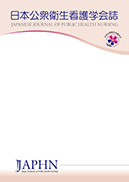Volume 4, Issue 2
Displaying 1-6 of 6 articles from this issue
- |<
- <
- 1
- >
- >|
Foreword
-
2015 Volume 4 Issue 2 Pages 111
Published: 2015
Released on J-STAGE: January 05, 2016
Download PDF (114K)
Research Article
-
2015 Volume 4 Issue 2 Pages 112-120
Published: 2015
Released on J-STAGE: January 05, 2016
Download PDF (344K) Full view HTML -
2015 Volume 4 Issue 2 Pages 121-129
Published: 2015
Released on J-STAGE: January 05, 2016
Download PDF (595K) Full view HTML
Public Health Nursing Report
-
2015 Volume 4 Issue 2 Pages 130-138
Published: 2015
Released on J-STAGE: January 05, 2016
Download PDF (1156K) Full view HTML -
2015 Volume 4 Issue 2 Pages 139-147
Published: 2015
Released on J-STAGE: January 05, 2016
Download PDF (488K) Full view HTML
The 3rd Japan Academy of Public Health Nursing Conference
Educational Lecture II
-
2015 Volume 4 Issue 2 Pages 148-158
Published: 2015
Released on J-STAGE: January 17, 2020
Download PDF (4326K)
- |<
- <
- 1
- >
- >|
